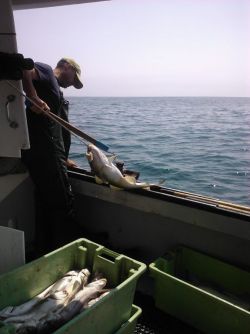Halifax Media Co-op
News from Nova Scotia's Grassroots
Haddock rebound offers opportunity for rethink, by Susanna Fuller and Justin Cantafio
This blog was originally posted at Small Scales, the excellent East Coast fisheries blog administered by the Marine Issues Committee of the Ecology Action Centre. Follow the always interesting Marine Issues Committee on Twitter.
The recent abundant landings of haddock from Georges Bank are indeed good news, particularly for fishing communities on Nova Scotia’s South Shore. It is a welcome reminder that formerly exploited wild fish populations can return to historic levels, following near collapse.
But it seems that we are missing an important opportunity here. While we have made catastrophic mistakes with our fisheries management in the past, now we have a chance to get it right. We have a chance to fundamentally improve how we manage, market and promote the public resources that are our fisheries and most importantly ensure that we have this resource into the future.
While stories of “bonanza” landings are encouraging, the other side of such high volumes being landed at once is that markets will be flooded. This results in low prices, ultimately forcing us to export most of that fish as a low value commodity on a bulk market.
Wholesale prices for haddock dropped by half after this month’s record landings by large trawlers. At this rate, smaller boats that fish by bottom hook and line will not be able to compete when their fishing season begins. Rumors abound that the haddock is being sold for $0.35/lb for lobster bait. Surely we can do better than this.
The lobster industry has struggled with similar issues over the past several years. High volumes and a high US dollar have spurred the appointment and subsequent recommendations of an independent Lobster Panel to advise on better supply management and marketing, among a suite of other measures, to ensure that this resource provides value for coastal communities and the thousands of people who depend on it both directly and indirectly.
The rapid harvest of large volumes of groundfish (particularly cod), combined with indiscriminate fishing methods is what has led us to a fundamentally changed marine ecosystem in little under 30 years. The return of the haddock population—at least a very strong 2009 year class—should prompt us to make different management and marketing decisions than we have in the past.
First and foremost, we should fish with the lowest impact fishing gear possible, as well as the gear that yields the highest quality fish.
For decades we were able to fish cod and haddock using bottom hook and line gear without compromising the populations, destroying habitat or overfishing juveniles. Over the last decade several countries haverestricted bottom trawling in vast areas of the ocean, in recognition of the environmental damage and as a result of shifting market demand for sustainable seafood products. In 2014, almost every large retailer in the US and Canada has a sustainable seafood purchasing policy. The marketplace is demanding bottom hook and line caught seafood.
Vancouver Aquarium’s Ocean Wise program has recently begun promoting handline groundfish as one of their approved fisheries. Sadly, the last commercial handliner in Nova Scotia stopped fishing several years ago because as the stocks collapsed, smaller boats couldn’t steam the long distances to find fish. Maybe it is time that we allowed the fish to come closer ashore.
Bottom hook and line fishermen continue to make up the backbone of many of Nova Scotia’s coastal communities. The growing demand for fish from low-impact fisheries provides an important opportunity for Nova Scotia to rethink a way forward that can maximize the value and employment benefits we can yield from our fisheries. This is key to the survival of our coastal communities and indeed ensuring that our young people have a viable future in traditional industries, and are able to re-imagine these industries to create the value that is needed.
The haddock rebound is great news. But Nova Scotians and the marine environment both deserve better than quick sweeps. It is not often we get a second chance to protect the future of our fisheries. The onus is not only on the Department of Fisheries and Oceans and the provincial Department of Fisheries and Aquaculture to work with stakeholders to ensure we are rethinking our fisheries, but also on the Canadian public to demand that we manage this resource for the greatest public good. Our future depends upon it.
Susanna Fuller and Justin Cantafio work on the Marine Team at the Ecology Action Centre. This article was also submitted as an Op-ed to the Chronicle Herald.
The site for the Halifax local of The Media Co-op has been archived and will no longer be updated. Please visit the main Media Co-op website to learn more about the organization.



